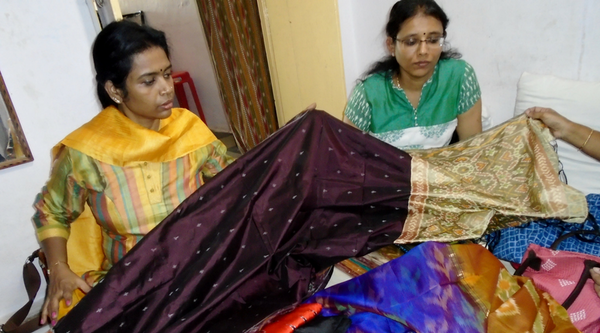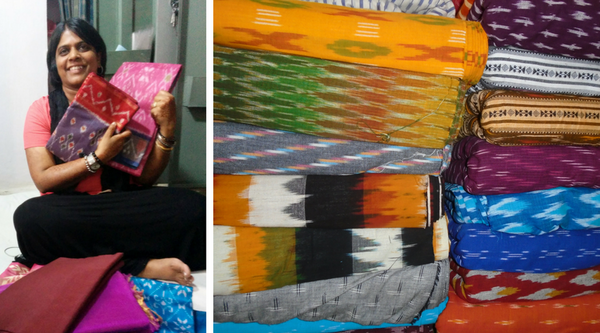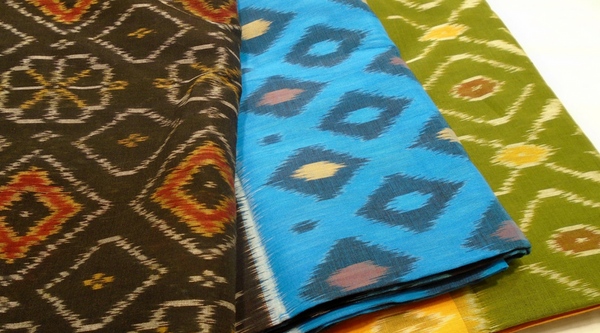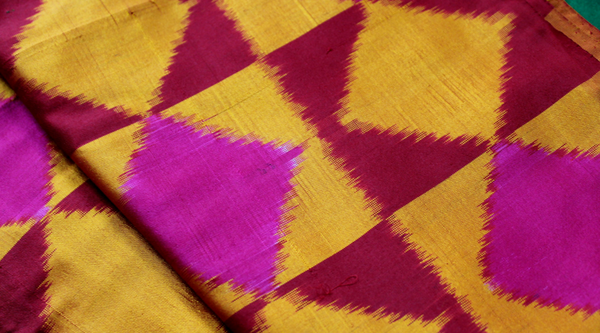
The best part of shopping for fabrics for Mayil scarves is that I do it with my friends and family. It is easy to rope them in since everyone likes shopping. Now that our kids are older, I am able to travel by myself to India; likewise, my childhood friends with their similarly aged kids are freer to travel to different cities with me. This past September three of my closest friends and I travelled to Hyderabad with the goal of finding Pochampally fabrics to design a new line of Mayil scarves.


I fondly recall my mother's one and only Pochampally sari in a rust brown, black and gold. Her sari featured a “koburam” (temple) design, a Pochampally characteristic. I have since then learned (due to my recent interest in all things textile) that triangular and other geometric patterns, like the “koburam,” are unique to the Pochampally type of weave - all hand loomed in and around Bhoodan Pochampally, Nalgonda district, Telangana State, India.
Google describes Pochampally as a cluster of eighty villages, which have been traditional weaving villages for over a century. Pochampally saris and dress materials are woven using the “ikat” technique and are therefore sometimes referred to as Pochampally ikats. Google some more, and you come across descriptions of Pochampally which include not so familiar words like double ikat, warp, weft, resist dying, bindings and lots of reference to the Bhoodan movement.


In the ikat weave the thread is dyed in an intricate pattern using the resist dye technique. With the resist dye technique, certain parts of the unwoven thread are covered and bound so that the dye only adheres to the exposed parts. This dyed thread is then woven. The ikat technique offers an intricate and mind-boggling alternative to traditional dying in which artists add color to pre-woven fabric. For an ikat design to work, the weaver must line the thread up in precisely the correct manner - imagine the amount of intricate planning required to weave even a simple triangle, let alone a small blue peacock! The complicated ikat technique results in completely reversible fabrics, and a characteristic “blurriness” in the colored design.


My own trip to this historic village started with an hour and a half drive down a rural highway from Hyderabad to Pochampally. A mere few turns after we left the highway, our driver casually told us “this is Pochampally.” There was no grand fanfare announcing this famous village. It consisted of one long street with shops on both sides displaying multicolored saris, all immediately recognizable by their characteristic Pochampally weave. The weavers’ houses were behind this main street of shops. We started our shopping at the Pochampally hand loom weavers’ society, which sources from a cooperative of about 160 weavers. There was a lovely selection of cotton, silk and silco (silk cotton blend) fabrics and sarees. After buying a few sarees we asked to look at the weaving process. The weavers were more than happy to oblige. Pots of hot dye boiled and long strands of yarn dried outside their yards. Inside, we found looms with ikats in different stages of completion. The entire length of one small side street was taken up by drying pre-dyed yarn. The weavers explained the process to us and let us take some pictures. We continued shopping up (or was it down?) the main street, entering shops where either the display was appealing or the shop owner eagerly invited us in with “great selections and good prices madams.” We returned to Hyderabad after a visual treat, loaded with saris and yards of soft silk, cotton and blended fabrics, all hand woven with traditional ikat patterns perfected over the course of a century. Scroll down and check out pictures and click through to Mayil Scarves' pochampally ikat collection.









Check out Mayil Scarves' pochampally ikat collection
Winter, summer, friends and fun - anytime is a good time to wear pochampally ikat scarves by Mayil
Read more about the Bhoodan movement here.
Read our traveler's note here.







